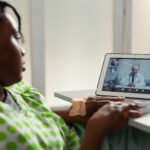Image-Based Abuse: Sexual Harassment in the Age of the Internet
Lula Dalupang
June 2024
Image-based abuse (IBA), otherwise known as “revenge porn”, is one of the consequences that arose during the age of the internet. As artificial intelligence (AI) rapidly develops and evolves, so does image-based abuse. Creating artificial images or videos containing sexual content is one of the fastest growing harmful uses of AI.1 Despite the proliferation of IBA and its consequences, the U.S. still does not have a federal law in place to criminalize perpetrators of IBA. Thus, IBA education is essential so that individuals with internet access possess the requisite knowledge to identify and respond appropriately to instances of IBA.

Understanding Image-Based Abuse
Image-based abuse is defined as forms of online harassment that weaponize sexually explicit images of an individual to control, humiliate, or otherwise cause them harm.3 A 2023 report by Panorama Global found that at least ten million Americans have experienced the threat, if not the reality, of having their intimate pictures exposed without their consent.1
Internet-based abuse can present itself in various different ways. The most common form of IBA is nonconsensual pornography (NCP), obtaining and/or sharing sexually explicit images and/or videos of an individual without their consent.3 The perpetrator can either be the sexual partner or a third-party individual. A similar type of IBA is “upskirting” and “downblousing”.2 As described in their names, this form of IBA consists of taking a photograph of an individual beneath their clothing without their consent (e.g. taking a photograph from below as the individual walks up the stairs).
Another form of IBA is “sextortion”, in which the perpetrator uses intimate images and/or videos of an individual as blackmail for continued harassment. This differs from leaking or hacking images, since the latter is a shorter form of abuse. Sharing intimate images outside of the intended recipient without the consent of the person in the image is a separate form of internet-based abuse.
Newer forms of internet-based abuse include deepfakes and cyberflashing. Deepfakes, as mentioned earlier, are AI generated images or videos of an individual, typically in an intimate context, created without their consent.3 Cyberflashing is a form of IBA that became more common with the rise of social media, messaging apps, and WiFi-based sharing (i.e. AirDrop). These technologies allow perpetrators to share unsolicited sexual images and/or videos, an example of which is colloquially known as “dick pics”.2
In order to comprehend the forms of IBA, first the definition of intimate images/videos must be understood. An intimate image/video must contain at least one of the following: nudity or partial nudity, genitals, private activities (e.g.; using the restroom, sexual intercourse), and/or lack of religious or cultural clothing (e.g.; turban, hijab).2 This definition includes instances of altered images, AI generated images, and falsely tagging an individual on sexual social media posts.
Consequences of Image-Based Abuse
Image-based abuse results in severe harm to the victimized individual. Through the personal lens, IBA is a traumatic event that causes serious mental health issues (e.g.; anxiety, PTSD, depression) in approximately 93% of survivors.3 Of the IBA survivors surveyed in 2023, 51% have contemplated suicide at some point in their life.1 IBA is often accompanied by secondary stressors that are detrimental to mental health as well. These harmful stressors include cyberbullying, sexual assault, domestic violence, hate crimes, financial hardships, and social isolation. All of which are also risk factors for internet-based victimization.
Certain demographics are at higher risk to internet-based abuse than others. Females are nearly twice as likely to be targeted than males, with the female demographic including young girls.1 1 in 4 survivors of sextortion were under the age of 13 during the abuse.3 Individuals from historically marginalized populations are also more likely to experience IBA. Members of the LGBTQ+ community are four times more likely to be targeted than heterosexual-identifying individuals. Vulnerable populations also experience greater difficulty in sharing their experiences. In a 2020 survey, only 4% of BIPOC survivors reported their abuse to law enforcement, compared to 16% of white survivors.1 Other barriers to law enforcement and other formal services include the individual’s socioeconomic status and whether the individual is safe in their current environment.3
Larger institutional barriers are in place due to the lack of a federal law criminalizing internet-based abuse. Only 38 states uphold state laws addressing some, if not all, forms of IBA.1 The variation in laws result in inconsistent enforcement of its policies and gaps in its regulations. Additionally, insufficient specialized training in trauma-informed care exists, thus survivors are unable to get the mental support they need either.
Supporting Survivors of Image-Based Abuse
With the varying laws and regulations surrounding internet-based abuse, it is essential to promote self-efficacy among internet users so that they adhere to the proper procedures following abuse. The first step of reporting IBA is collecting evidence. This step requires taking screenshots or screen recordings of any and all contacts from the perpetrator and their account(s). The context of the abuse is critical information as well, so timestamps, dates, and the online platforms where the perpetrator initiated contact should be taken into account. Any reports made to the platforms should be recorded as well.
Once evidence is collected, the next step of reporting internet-based abuse is filling out the report form. If the individual filling out the form is reporting on behalf of someone else, consent must be obtained from the person experiencing IBA before proceeding with the form. The next step is to eliminate any further contact with the perpetrator. This may be accomplished by blocking the perpetrator’s accounts, muting the perpetrator’s posts or comments, and setting personal social media accounts to private. Free services also exist to remove non consensual intimate images from online platforms. For images in which the individual is a minor, takeitdown.ncmec.org uses hash values to detect and remove the images. For images in which the individual is 18 or over, stopncii.org utilizes a similar algorithm to delete any copies of the image on public platforms. Once these steps are all completed, the process moves on to helping the survivor recover.
Recovering from image-based abuse is a journey that must overcome the trust that the perpetrator broke and the sense of control that the survivor lost. To help survivors regain their trust and self-empowerment, it is important to take these emotional traumas in mind when talking with survivors about their abuse. Word choice often can have a larger impact than intended. Avoiding asking questions with “why” helps decrease the self-blame that the survivor associates with their abuse. Personal biases, beliefs, or assumptions may also have a negative impact on the survivors so one must acknowledge and remove these topics from the conversation prior to speaking with a survivor. This also prevents personal advice from being projected, so that the survivor has the space to guide their own process. While the survivor takes the lead in the conversation, it is important to continue challenging negative self-talk. Survivors tend to socially isolate after abuse, due to feelings of shame, guilt, and self-blame. Highlighting a survivor’s strengths and validating their reactions combat the negativity.
In order to combat sexual abuse overall, a greater commitment to sexual education is required. Many schools do not provide comprehensive sexual education, focusing rather on celibacy or fear tactics (e.g.; sexually transmitted diseases, pregnancy). Younger generations often turn to pornography as a substitute for sexual education, which results in harmful beliefs that confuse pleasure with pain and typically objectifies one of the participants in intercourse. Education systems are failing to address key concepts, such as affirmative consent, that empowers individuals in their sexual citizenship by informing them of their autonomy.
References
[1] I didn’t consent: A global landscape report on image-based sexual abuse(2023). Panorama Global.
[2] Image-based abuse. (2023). Retrieved June 8, 2024, from https://www.esafety.gov.au/ key-topics/image-based-abuse
[3] Image-based abuse (formerly: sextortion/revenge porn). (2024). Retrieved June 8, 2024, from https://app.crisistextline.org/toolbox[4] Klein, J., & Prabhakar, A. (2024). A call to action to combat image-based sexual abuse. Retrieved June 8, 2024, from https://www.whitehouse.gov/gpc/briefing-room/2024/05/ 23/a-call-to-action-to-combat-image-based-sexual-abuse/





